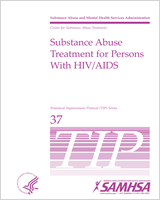This is an open-access report distributed under the terms of the Creative Commons Public Domain License. You can copy, modify, distribute and perform the work, even for commercial purposes, all without asking permission.
NCBI Bookshelf. A service of the National Library of Medicine, National Institutes of Health.
Substance Abuse Treatment for Persons With HIV/AIDS [Internet]. Rockville (MD): Substance Abuse and Mental Health Services Administration (US); 2000. (Treatment Improvement Protocol (TIP) Series, No. 37.)

Substance Abuse Treatment for Persons With HIV/AIDS [Internet].
Show detailsCD4+ T-Lymphocyte Categories
The three CD4+ T-lymphocyte categories are defined as follows:
- ▪
Category 1: ≥500/mL
- ▪
Category 2: 200–499/mL
- ▪
Category 3: <200/mL
These categories correspond to CD4+ T-lymphocyte counts per mL of blood and guide clinical and therapeutic actions in the management of HIV-infected adolescents and adults. The revised HIV classification system also allows for the use of the percentage of CD4+ T cells.
HIV-infected persons should be classified based on existing guidelines for the medical management of HIV-infected persons. Thus, the lowest accurate, but not necessarily the most recent, CD4+ T lymphocyte count should be used for classification purposes.
Clinical Categories
The clinical categories of HIV infection are defined as follows:
Category A
Category A consists of one or more of the conditions listed below in an adolescent or adult (≥ 13 years) with documented HIV infection. Conditions listed in Categories B and C must not have occurred.
- ▪
Asymptomatic HIV infection
- ▪
Persistent generalized lymphadenopathy
- ▪
Acute (primary) HIV infection with accompanying illness or history of acute HIV infection
Category B
Category B consists of symptomatic conditions in an HIV-infected adolescent or adult that are not included among conditions listed in clinical Category C and that meet at least one of the following criteria:
- ▪
The conditions are attributed to HIV infection or indicate a defect in cell-mediated immunity
- ▪
The conditions are considered by physicians to have a clinical course or to require management that is complicated by HIV infection. Examples of conditions in clinical Category B include, but are not limited to
- ⋄
Bacillary angiomatosis
- ⋄
Candidiasis, oropharyngeal (thrush)
- ⋄
Candidiasis, vulvovaginal: persistent, frequent, or poorly responsive to therapy
- ⋄
Cervical dysplasia (moderate or severe)/cervical carcinoma in situ
- ⋄
Constitutional symptoms, such as fever (38.5° C) or diarrhea lasting >1 month
- ⋄
Hairy leukoplakia, oral
- ⋄
Herpes zoster (shingles), involving at least two distinct episodes or more than one dermatome
- ⋄
Idiopathic thrombocytopenic purpura
- ⋄
Listeriosis
- ⋄
Pelvic inflammatory disease, particularly if complicated by tubo-ovarian abscess
- ⋄
Peripheral neuropathy
For classification purposes, Category B conditions take precedence over those in Category A. For example, someone previously treated for oral or persistent vaginal candidiasis (and who has not developed a Category C disease) but who is now asymptomatic should be classified in clinical Category B.
Category C
Category C includes the clinical conditions listed in the AIDS surveillance case definition (below). For classification purposes, once a Category C condition occurs, the person will remain in Category C.
- ▪
Candidiasis of bronchi, trachea, or lungs
- ▪
Candidiasis, esophageal
- ▪
Cervical cancer, invasive*
- ▪
Coccidioidomycosis, disseminated or extrapulmonary
- ▪
Cryptococcosis, extrapulmonary
- ▪
Cryptosporidiosis, chronic intestinal (>1 month's duration)
- ▪
Cytomegalovirus disease (other than liver, spleen, or nodes)
- ▪
Cytomegalovirus retinitis (with loss of vision)
- ▪
Encephalopathy, HIV-related
- ▪
Herpes simplex: chronic ulcer(s) (>1 month's duration); or bronchitis, pneumonitis, or esophagitis
- ▪
Histoplasmosis, disseminated or extrapulmonary
- ▪
Isosporiasis, chronic intestinal (>1 month's duration)
- ▪
Kaposi's sarcoma
- ▪
Lymphoma, Burkitt's (or equivalent term)
- ▪
Lymphoma, immunoblastic (or equivalent term)
- ▪
Lymphoma, primary, of brain
- ▪
Mycobacterium avium complex or M. kansasii, disseminated or extrapulmonary
- ▪
Mycobacterium tuberculosis, any site (pulmonary or extrapulmonary)
- ▪
Mycobacterium, other species or unidentified species, disseminated or extrapulmonary
- ▪
Pneumocystis carinii pneumonia
- ▪
Pneumonia, recurrent**
- ▪
Progressive multifocal leukoencephalopathy
- ▪
Pulmonary pneumonia
- ▪
Salmonella septicemia, recurrent
- ▪
Toxoplasmosis of brain
- ▪
Wasting syndrome due to AIDS
*This expanded definition requires laboratory confirmation of HIV infection in persons with a CD4+T lymphocyte count of fewer than 200 cells/mL or with an added clinical condition.
**Added as AIDS-defining illness in the 1993 expansion of the AIDS surveillance case definition, when occurring in persons with HIV infection.
Source: Castro et al., 1992.
- Appendix C 1993 Revised Classification System For HIV Infection and Expanded AID...Appendix C 1993 Revised Classification System For HIV Infection and Expanded AIDS Surveillance Case Definition For Adolescents and Adults - Substance Abuse Treatment for Persons With HIV/AIDS
Your browsing activity is empty.
Activity recording is turned off.
See more...